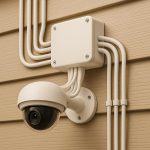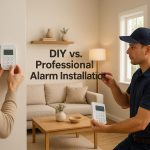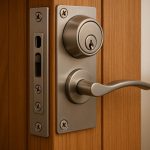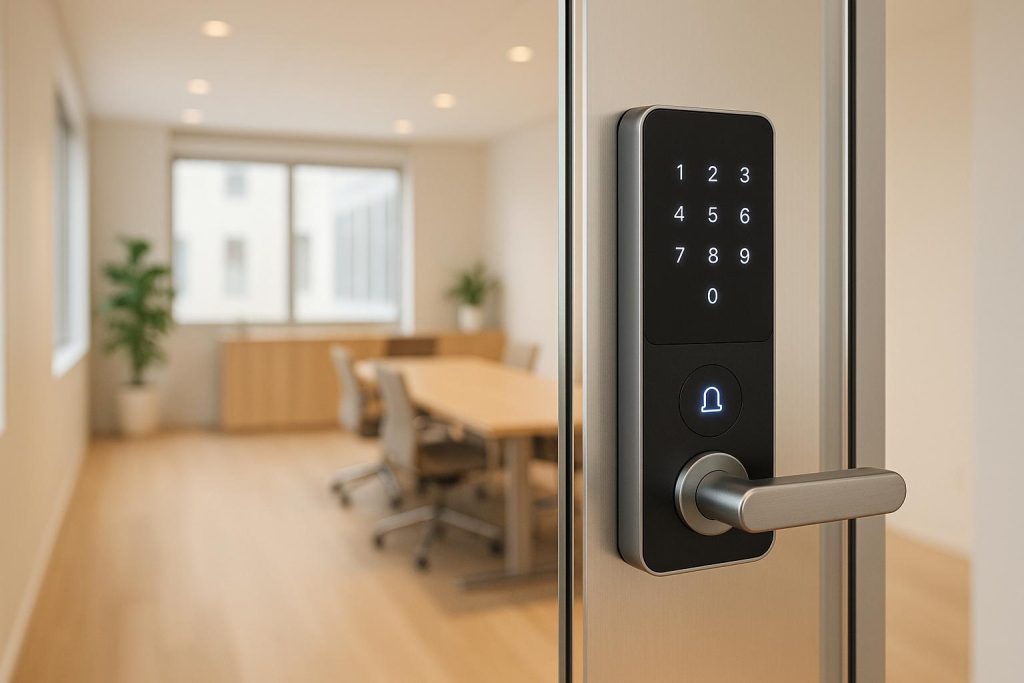Access control systems paired with smart locks are reshaping building security. These systems combine advanced hardware and software to manage who enters specific areas, when, and how. Smart locks add remote functionality, keyless convenience, and integration with other systems like video surveillance or alarms. Together, they offer centralized control, real-time monitoring, and better visitor management.
Key Points:
- Access Control Systems: Manage access with hardware like controllers and credential readers (keypads, cards, biometrics) and software for permissions and logs.
- Smart Locks: Operate via Bluetooth, Wi-Fi, or Zigbee, enabling remote control, temporary access, and activity notifications.
- Integration Benefits: Centralized management, automated responses, enhanced security, and cost efficiency by reducing manual processes.
- Setup Essentials: Ensure hardware-software compatibility, proper site preparation, and professional installation for reliable performance.
For businesses, residential complexes, or institutions, combining these systems simplifies security while improving functionality. Professional locksmiths ensure proper installation and maintenance, avoiding common issues like connectivity failures or mismatched protocols.
16 Smart Locks Tested So You Don’t Have To
Required Components and Setup Requirements
Setting up smart locks with access control systems demands the right combination of hardware, software, and site preparation to ensure everything runs smoothly and reliably over time. Knowing what components are needed and making sure they work together seamlessly can make all the difference for a successful installation.
Required Hardware and Software
At the heart of any access control system are the smart locks themselves. These can range from electronic locks with keypads to wireless models that connect to your network. These locks communicate with access controllers or panels, which serve as the system’s command center – processing credentials and sending signals to lock or unlock doors.
Additional hardware like credential readers enhances the system’s functionality. These readers include:
- Keypads for PIN entry
- Card readers for proximity cards and key fobs
- Biometric scanners for fingerprint or facial recognition
To further monitor and secure access points, door position sensors and request-to-exit sensors can be added. These devices track door status and detect when someone exits a secure area.
Most access control hardware operates on low-voltage power, typically 12V or 24V DC. For wireless systems, gateways or hubs are essential for connecting smart locks to the broader access control platform.
On the software side, a management platform is critical. These platforms handle user credentials, permissions, and event logs. Popular solutions from brands like Lenel, Kisi, Openpath, Brivo, and Avigilon offer centralized dashboards that allow for remote management, real-time notifications, and integration with other systems like CCTV and alarms.
Finally, ensure that your hardware and software support the same communication protocols to maintain smooth network performance.
System Compatibility and Communication Protocols
Once you’ve chosen your hardware, it’s vital to confirm that all components communicate effectively. Common communication protocols include Z-Wave, Zigbee, Wi-Fi, and Bluetooth. Some systems rely on proprietary or widely used protocols like HID or iCLASS for credential management. Always check compatibility lists and integration guides from both the smart lock and access control system manufacturers before making any purchases.
Battery life for high-quality smart locks typically lasts between 6 months and 2 years, with most systems offering advance alerts when batteries need replacing. Additionally, ensure strong network coverage – whether through reliable Wi-Fi or dedicated connections – for consistent, real-time communication between devices.
Site Preparation and Installation Requirements
Proper site preparation is key to avoiding installation headaches and ensuring the system’s long-term reliability. Start by checking door compatibility to make sure the selected smart locks fit without requiring modifications.
Next, assess your network infrastructure. For wireless systems, confirm that Wi-Fi signals are strong enough to reach every door location. For wired systems, plan for proper cable routing and ensure connection points are accessible. Reliable power sources – either through existing outlets or dedicated wiring – are also essential for controllers and hardwired locks.
When positioning sensors and readers, aim for optimal functionality and tamper resistance. In commercial settings, fire and safety regulations may dictate specific placement requirements, so be sure to review these beforehand.
Professional installation is highly recommended, especially for larger or more complex setups. According to industry experts:
"Our team of experts is highly skilled, certified, and continually trained in the most advanced technologies, ensuring top-notch locksmith solutions." – Sherlock’s Locksmith
Certified locksmiths bring expertise in installation, system configuration, and ongoing maintenance. They can handle site-specific challenges, manage intricate wiring or retrofitting, and ensure compliance with local codes. For example, Sherlock’s Locksmith in Pittsburgh, PA, offers professional installation services for both residential and commercial systems, ensuring everything is done to industry standards.
The complexity of the installation process increases with the number of doors and the sophistication of the access control features. Common mistakes – such as mismatched protocols, weak network signals, poor wiring, or insufficient planning – can lead to operational issues. By working with experienced professionals and following manufacturer guidelines, you can avoid these pitfalls and have a system that functions reliably from day one.
Step-by-Step Integration Guide
Setting up smart locks with access control systems requires careful planning and execution to ensure everything works smoothly. The process unfolds in three main phases, each building on the last for a successful outcome.
Planning and System Assessment
Start by creating a detailed inventory of all doors, locks, and access points. This will serve as your roadmap for the integration process.
Next, check the compatibility between your current access control system and the smart locks you’re considering. Look into the communication protocols your system supports, such as Z-Wave, Zigbee, Bluetooth, or Wi-Fi. Review the manufacturer’s documentation to confirm that the systems can communicate effectively.
Clearly outline what you hope to achieve with the integration. Are you aiming for remote management, detailed audit trails, or better visitor access? Defining these goals early helps guide your choices for hardware and budget planning. Don’t forget to include the cost of the locks and any professional installation fees in your budget.
Think ahead to future needs. Will you need to add more doors or connect the system with other building features later? Planning for scalability now can save you from costly headaches down the line.
A site survey is critical before installation begins. Check for potential obstacles like wiring requirements for hardwired systems or weak wireless signals at door locations. Assess the overall condition of doors and frames to ensure they can support the new hardware without significant changes. If unique challenges arise, consult a certified locksmith to address them effectively.
Installation and Device Configuration
Once your plan is ready, move on to installing and setting up the devices. Start by removing existing hardware and documenting the setup with photos for reference.
Follow the manufacturer’s instructions to mount each smart lock, ensuring proper alignment and secure installation. For battery-powered locks, insert fresh batteries and confirm they are seated correctly. For hardwired systems, verify that they are connected to the appropriate power source, typically 12V or 24V DC.
Position the locks to reduce tampering risks while maintaining functionality. If additional sensors like door position monitors or request-to-exit devices are part of the setup, install them with the same level of care.
Next comes configuration. Pair each smart lock with your access control system using the designated management platform, which is often a mobile app or web-based control panel. Follow the pairing process step by step, as skipping details can lead to connectivity problems.
Set up core features like lock timing, fail-safe behaviors, and emergency overrides. Test each lock during this phase to troubleshoot any issues early. For wireless systems, confirm that all locks maintain a strong connection to their gateway or hub and resolve any connectivity issues as soon as they arise.
System Connection and Testing
After installation and configuration, it’s time to connect and test the entire system. Link each smart lock to the management platform, enroll the devices, and assign them to specific zones.
Set up user permissions through the management platform. Create groups for employees, contractors, and visitors, and assign credentials like key cards, fobs, or mobile access accordingly. Make sure these permissions align with your security policies.
If your access control system supports devices from various brands, check that all locks are displayed correctly in the management interface. Update lock information as needed for clear identification of each access point.
Testing is a crucial step to ensure everything functions as it should. Confirm that each lock responds to access commands from the central platform and that all credentials work across different access methods. Test backup solutions, like physical keys, to ensure they operate correctly.
Check that audit trails are being generated for every access event. These logs are important for security and can help identify communication issues between devices. Also, verify that alerts for low batteries, forced entry, or system malfunctions reach the right personnel.
Don’t skip testing fail-safe and emergency features. Simulate power outages, network disruptions, and manual overrides to confirm the system behaves as expected under stress. Test battery backup systems as well.
Finally, run practical scenarios to mimic real-world use. For example, test how the system handles visitor access, group access during shift changes, or lockdown protocols. These tests often uncover issues that basic functionality checks might miss.
Address any problems identified during testing before putting the system into full operation. Common issues include protocol mismatches, weak wireless signals, power supply problems, and software errors. Following manufacturer guidelines and working with certified installers can help you avoid these pitfalls and ensure the system runs reliably for the long term. Thorough testing paves the way for smooth operation and ongoing maintenance.
sbb-itb-643e28e
Benefits and Applications of Integrated Systems
When systems are successfully connected and tested, the advantages of integration become clear. By combining smart locks with access control systems, security management becomes more streamlined, improving efficiency, operational control, and overall safety. These benefits have made such systems increasingly appealing across a variety of settings.
Main Benefits of Integration
One of the standout advantages of integrated systems is centralized management. Instead of juggling multiple locks and credentials, administrators can manage all access points from a single platform. This makes tasks like revoking access for former employees or tenants quick and hassle-free – no need to collect keys or reprogram individual locks.
Another benefit is remote access control, which allows property managers or business owners to lock or unlock doors from anywhere using an internet connection. Temporary digital keys can be issued for specific timeframes, automatically expiring when no longer needed. This is especially handy for granting short-term access to guests or contractors.
Enhanced security is another significant upside. Integrated systems provide real-time monitoring and maintain detailed audit trails, logging every access attempt by user, time, and location. When paired with video surveillance, these systems offer visual confirmation of events, while automated alerts notify administrators of unusual activities or security breaches.
Operational efficiency also sees a boost. By automating routine tasks, integrated systems can reduce security management costs by up to 30%. Fewer manual processes mean fewer chances for human error, making operations smoother and more reliable.
In emergencies, these systems shine even brighter. Whether it’s a fire alarm or a security threat, integrated systems can automatically unlock exit doors for evacuation while securing sensitive areas, ensuring occupants are protected without delay.
Common Applications
Integrated systems are proving their worth in a wide range of environments, including commercial buildings, residential complexes, and institutional facilities.
Commercial buildings are a prime example. Office complexes use these systems to manage employee access, control visitors, and automate security responses. For instance, a 2024 survey revealed that over 60% of new commercial building projects in the U.S. now include integrated access control and smart lock systems as part of their security plans. Businesses can issue temporary digital keys to contractors, initiate automated lockdowns during emergencies, and link access events to video surveillance for better monitoring.
In residential complexes, keyless entry and remote guest access are major draws. Property managers can send digital keys through smartphone apps, revoke access instantly when leases end, and manage shared spaces like gyms or pools efficiently. Residents enjoy the convenience of smartphone-based access, while property managers gain tighter control over building security.
Institutional settings – such as schools, hospitals, and government facilities – use integration for restricted area management, emergency lockdowns, and visitor tracking. Schools can automate lockdowns during threats, hospitals can secure sensitive areas like medication storage, and detailed logs help meet compliance requirements while enhancing security.
The shift toward cloud-based platforms has made these systems even more accessible, especially for smaller properties. Mobile credentials, such as those stored on smartphones, are quickly replacing traditional keys and cards in both commercial and residential settings.
Application Comparison
Different environments benefit from integrated systems in unique ways, but each comes with its own set of challenges.
| Setting | Main Benefits | Limitations/Challenges |
|---|---|---|
| Commercial Buildings | Centralized control, detailed audit trails, HR/IT integration, scalable systems | Higher upfront costs, complex setup, extensive credential management |
| Residential Complexes | Remote access, guest management, smart home integration, keyless convenience | Privacy concerns, internet dependency, battery maintenance |
| Institutional Facilities | Emergency automation, compliance support, layered security, real-time monitoring | Regular maintenance, staff training, regulatory compliance complexity |
For commercial buildings, the focus is on managing large numbers of employees, contractors, and visitors. Although initial costs and complexity may be higher, the comprehensive security and control offered often make the investment worthwhile.
In residential settings, simplicity and convenience are key. Residents want easy smartphone access, while property managers appreciate systems that reduce maintenance headaches and improve security.
Institutional environments, on the other hand, must meet strict security requirements while ensuring safety during emergencies. Regulatory compliance often dictates the design and operation of these systems, adding layers of complexity.
Regardless of the setting, professional installation and ongoing support are vital. Certified locksmiths, such as Sherlock’s Locksmith, provide expert installation and 24/7 emergency assistance to ensure systems remain reliable.
To get the most out of integrated systems, proper installation, regular maintenance, and user training are essential. These elements help maximize the benefits while minimizing potential security risks.
Professional Locksmith Services for Smart Lock Integration
When it comes to smart lock integration, professional locksmith services are essential for ensuring both security and reliability over time. While access control systems offer advanced features, their effectiveness hinges on proper installation and regular upkeep. Combining smart locks with access control platforms is no simple task – it requires a level of expertise that goes beyond basic locksmithing. Professionals skilled in both traditional and digital security systems are key to making these integrations work seamlessly and securely.
Role of Certified Locksmiths
Certified locksmiths bring a level of expertise that DIY efforts simply can’t match. Their role extends far beyond hardware installation. They ensure system compatibility, configure communication protocols like Z-Wave and Zigbee, and integrate smart locks into existing security setups. All of this is done while adhering to local regulations, including building codes, fire safety standards, and ADA accessibility requirements.
One common issue property owners face is managing multiple smart devices through separate apps and platforms, which can lead to security gaps and operational headaches. Certified locksmiths address this by creating unified systems that allow all access points to be controlled from a single platform.
These professionals also handle the technical side of integration. They perform site assessments, choose compatible hardware and software, and follow best practices for network security and device configuration. Additionally, they test all components – such as backup systems – to ensure functionality during power outages or network failures.
"Our technicians are certified locksmiths who undergo continuous training to stay current with industry standards. This ensures we can quickly diagnose issues and provide reliable solutions that meet your expectations."
The numbers back this up: over 60% of businesses that professionally installed integrated access control systems reported fewer security incidents within the first year. Meanwhile, DIY installations often struggle with compatibility issues, security risks, and higher failure rates.
Certified locksmiths lay the foundation for dependable and efficient smart lock integration, a standard that Sherlock’s Locksmith exemplifies.
Why Choose Sherlock’s Locksmith

Sherlock’s Locksmith blends traditional locksmith expertise with modern security solutions. Based in Pittsburgh, PA, Sherlock’s Locksmith offers a full range of smart lock integration services. Their certified technicians specialize in access control systems, keyless entry, electronic locks, biometric systems, and comprehensive security system integration for both homes and businesses.
Continuous training keeps their team up-to-date with the latest technologies, enabling them to handle even the most complex integration projects involving various communication protocols and security platforms.
Their 24/7 emergency support is a lifeline for businesses that can’t afford downtime. Whether it’s a smart lock malfunction or an access control system failure, Sherlock’s Locksmith’s mobile units respond promptly with the tools and expertise to restore security. Their commitment to service is reflected in their impressive 4.9 out of 5 rating from 122 Google reviews.
Professional installation costs typically range from $150 to $500 per lock, depending on the complexity of the system. While this may be a higher upfront cost compared to DIY options, the long-term benefits – like enhanced security, regulatory compliance, and fewer system failures – make it a worthwhile investment.
Recent customer stories highlight the value of their services. For example, Tiffany Katter shared how a Sherlock’s Locksmith technician replaced a broken lock and installed a new smart lock system efficiently, despite her being out of state. Similarly, Matthew Kravits praised their excellent communication and fair pricing, noting that his technician completed the integration faster than expected.
"When you hire Sherlock’s Locksmith, you’re working with professionals who prioritize quality and customer satisfaction. We are licensed, insured, and adhere to industry standards, giving you peace of mind that the job will be done right."
Maintaining System Reliability
Even after installation, regular maintenance is crucial for keeping systems running smoothly. Certified locksmiths provide ongoing maintenance services that include battery checks, firmware updates, hardware inspections, and connectivity testing.
These routine tasks help prevent issues like battery failures, outdated firmware vulnerabilities, and network connectivity problems. They also ensure that user permissions are kept up-to-date to avoid unauthorized access. Skipping maintenance can lead to downtime, security breaches, and expensive emergency repairs.
Sherlock’s Locksmith offers maintenance contracts ranging from $100 to $300 per year per site. These contracts cover routine inspections, updates, and emergency support, helping identify potential problems before they escalate into major issues. This ensures that your integrated access control systems remain reliable.
Professional maintenance also includes user training for system administrators. This training minimizes user errors and equips property managers with the knowledge to manage credentials, review audit logs, and respond effectively to system alerts – something often overlooked in DIY setups.
As access control systems continue to evolve, particularly with the shift toward cloud-based solutions, professional support becomes even more critical. Certified locksmiths like those at Sherlock’s Locksmith provide the expertise needed to troubleshoot and maintain these interconnected systems, ensuring they meet security and compliance standards.
For property managers and businesses considering smart lock integration, partnering with certified professionals like Sherlock’s Locksmith is a smart choice. Their technical know-how, regulatory compliance, and ongoing support maximize the value of your investment in integrated security systems.
Conclusion
Bringing smart locks and access control systems together is reshaping the way we approach modern security. This integration creates a unified platform that not only enhances security but also makes managing access far more convenient. For property owners and businesses, it means centralized control over entry points, real-time monitoring, and the ability to grant or revoke access instantly – no matter where they are. These upgrades translate directly into streamlined operations and noticeable financial savings.
The numbers back it up. Integrated systems cut administrative work by as much as 30%, while the market for these technologies is expected to hit $4.4 billion by 2027. For businesses that once juggled multiple platforms or relied on manual processes, this shift offers a clear path to reduced costs and increased efficiency.
To ensure these systems work seamlessly, professional installation and ongoing maintenance are key. Certified locksmiths bring the expertise needed to navigate compatibility issues, configure systems correctly, and fine-tune performance. Their know-how ensures the systems run smoothly and adapt to evolving security challenges, minimizing the risk of operational hiccups.
Planning ahead is just as important. Opting for systems that use open communication protocols like Z-Wave or Zigbee allows for future scalability, while routine firmware updates, battery checks, and system audits keep everything functioning at its best.
This integration reflects broader trends in smart building technology and mobile credentialing, offering solutions that align with rising tenant expectations and stricter regulatory demands. These systems provide a flexible, forward-looking foundation that maintains top-tier security while adapting to changing needs.
FAQs
What are the benefits of using smart locks with access control systems in commercial spaces?
Integrating smart locks with access control systems in commercial settings brings a host of benefits. For starters, it boosts security by enabling remote control and monitoring of access points, ensuring that only authorized individuals can enter restricted areas. Plus, with real-time entry logs, you gain valuable insights into who accessed specific locations and at what time.
On top of that, smart locks offer greater convenience. By eliminating the need for physical keys, they reduce the risks associated with lost or stolen keys. These systems also allow for customizable access permissions, making it simple to grant or revoke entry for employees, contractors, or visitors. For businesses, this blend of enhanced security and flexibility can simplify daily operations while creating a safer environment overall.
How can I make sure my smart lock works seamlessly with my access control system during installation?
To make sure your smart lock works seamlessly with your access control system, start by checking that both devices use the same communication protocols, such as Bluetooth, Wi-Fi, or Z-Wave. You can find these details in the manufacturer’s specifications, along with information about compatible system pairings.
Next, ensure the smart lock’s features match your specific needs – whether that’s remote access, managing user permissions, or scheduling access times. If you’re uncertain about compatibility, reaching out to a professional locksmith can save you from potential headaches. For those in Pittsburgh, PA, Sherlock’s Locksmith offers expert advice and installation services to get you set up with ease.
What maintenance is needed to ensure a smart lock and access control system work properly over time?
To keep your smart lock and access control system running smoothly, regular upkeep is crucial. Start by testing the system every so often to confirm that all parts – like locks, readers, and software – are working as they should. Make sure to update the firmware and software when necessary to stay secure and compatible with the latest advancements.
It’s also a good idea to clean the hardware, including locks and keypads, to prevent dirt or debris from causing performance issues. For battery-powered smart locks, keep an eye on the battery levels and replace them as needed to prevent unexpected interruptions. If any of this feels overwhelming, you can always reach out to a professional locksmith service, such as Sherlock’s Locksmith, for expert guidance.









